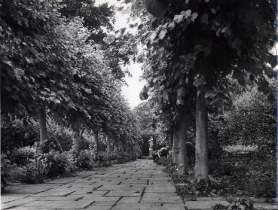Sissinghurst is not a great garden it is an outstanding garden; a result of the creative tension between the formal design of Harold and the exuberant planting of Vita. Made between 1930 and 1962, the garden today remains one of the most iconic in the world.
Their aim was never to make a great garden for posterity; they intended it solely as a place for their own pleasure and enjoyment. Their shared tastes governed the garden; these tastes excluded stiff bedding plants, coarse leaves and contrast. They liked a mix of elegant spires and colourful carpets of small plants in lavish abundance.
Vita was particularly fascinated by plants with historical or literary associations. She admired Norah Lindsey, Constance Spry and William Robinson, whilst Harold had a deep love and knowledge of classical art and architecture. They were both surprisingly well organised gardeners, always keeping copious notes and lists. Vita’s garden notebooks demonstrates what a perfectionist she was, never satisfied with a planting which could be improved. Harold’s notebooks (1946 to1962) mapped the plant content on each side of the Lime Walk, notes on what looked good with what. To Harold, beset with many career troubles, the garden was not only a creative occupation, but a companion and a comfort.
The Lime Walk Description
The Walk is formed by two rows of pleached limes either side of a central walkway paved with York stone. There are small squares of planting at the base of each tree, with larger planting beds on the outer edges bounded by concrete paving. The whole walk is enclosed by hornbeam hedging. This is broken at the southwest end for the Bacchante/ White Garden vista and narrowly for a shorter vista through the north-south axis of the Cottage Garden. Terracotta pots are placed along the outer edge and around the apsidal west end.
The formal lines and low, intricate ground-level planting are a contrast with the adjacent rooms from which the walk is entered, and with the more naturalistic Nuttery which is in flower at the same time. Its position at the edge of the garden gives it one of the few links to the wider estate, which can be glimpsed though a gap in the hedge.
Vita described it as ‘a spring garden suggesting the foreground of Botticelli’s Primavera’ which provides a rich carpet of flowers from March to early May. Today, the planting is based around clusters of plants in strong colours such a red tulips, orange Fritillaria imperialis, bright yellow Euphorbia polychroma and daffodils, calmed by white and cream flowers such as Erythronium ‘White Beauty’, Leucojums and wood anemone.
Harold’s garden
The design was Harold’s response to the fact that he could not create a unifying axis through the Rose Garden, Cottage Garden and Nuttery. Limes were planted in 1932 and the paving laid in 1936. It was always regarded as Harold’s garden. He paid Sidney the gardener’s wages himself, while Vita had to meet all the other costs of running Sissinghurst.
From 1946 until Vita’s death in 1962 he kept a detailed year-by-year account of what was planted, flowering times, how well plants had done and intentions for new schemes. Thus, in contrast to the struggle for precise information about the rest of the garden, it would be possible to re-create the planting of the walk exactly in any one of the 16 years covered by the notebooks.
In the beginning there were robust shrubs such as Forsythia, brooms and Rosa rugosa on the outer beds, but as time went on they were gradually removed, sometimes because they were getting too big, but mainly to give more room for bulbs. By 1959 only Cytisus x praecox and Prunus tenella ‘Fire Hill’ remained. New plants were constantly being introduced, including many native woodland plants, such as primroses and violets, forget- me-nots and pulmonaria, and other plants which blend naturally with bulbs – Euphorbia pilosa major and E. myrsinites, dwarf irises, auriculas, polyanthus, Phlox subulata,Viola labradorica, V. septentrionalis and Violetta ‘Lady Sackville’. The innumerable small bulbs, some of them species, some choice hybrids, include tulips, anemones, fritillaries, narcissi, erythroniums, muscari, scillas, chionodoxa.
Many small bulbs and creeping flowers escape from the borders and push their way up through the flagstones of the path: muscari, dwarf irises, thyme, anemones, fritillaries, erythronium, tiny rock narcissi, viola labradorica and occasional tulips.
A large oil jar half way down the walk is brimming with Clematis macropetala. The Tuscan lemon pots which flank the walk are planted with Tulips.
This is the only one of the garden rooms created and planted solely by Harold. He described it as ‘My Life’s Work’. It was central to the Sissinghurst spring and more formal than the Nuttery and Orchard. This formality serves as a transition between the intensity of the Rose Garden and Cottage Garden and the Nuttery and the wider estate.
Troy Smith, Head Gardener








